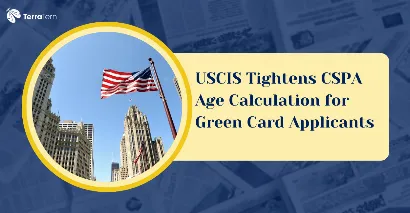Key Highlights
The USCIS CSPA age calculation is in the spotlight this August, and new regulations will be introduced as of August 15, 2025. The interpretation of the Child Status Protection Act (CSPA) policy has been important to most families seeking green cards , particularly to those who may greatly benefit when it comes to impacting children fast approaching the age of 21. These changes might make a huge impact on your immigration experience, whether you are an H-1B family, applying under the employment-based, or adjusting status within the US.
What Has Changed in USCIS CSPA Age Calculation?
Big changes are coming to how the USCIS CSPA age calculation works for green card applicants starting August 15, 2025.
Previous Policy (Feb 2023 – Aug 2025)
-
Up until recently, USCIS occasionally authorised applicants to rely on the “Dates for Filing” column in the monthly Visa Bulletin to determine when a visa was actually available as a means of freezing a child to no more than 21 years old.
-
This had the effect of making more children eligible to be accorded green cards alongside their parents, although they might have been over the age of 21 years by the time they had actually received a visa.
New Policy (Effective August 15, 2025)
-
As of August 15, the US will ONLY calculate the CSPA age of the US green card applicants by referring to the USCIS chart titled, “Final Action Dates.”
-
This puts in place the same procedure as dealt with by the Department of State, which has never abandoned the more rigid Final Action Dates approach.
-
Applications which have been pending (i.e. filed before August 15) will remain subject to the Feb 2023 rules, leaving some families with a final chance.
Also Read: US Tourist Visa Cost for Indian: Latest Guide & Fees
What Is the Child Status Protection Act (CSPA)?
Understanding the Child Status Protection Act (CSPA) is vital for families seeking green cards in the United States.
-
The CSPA law, passed in 2002, helps certain children remain eligible for green cards after their 21st birthday by “freezing” age for immigration purposes.
-
Children “age out” and lose eligibility if they turn 21 before their green card is issued and their CSPA age isn’t protected.
How is the CSPA Age Calculated?
|
Step |
Description |
Example (from USCIS) |
|
1 |
Find Age When Visa Becomes Available |
21 years, 4 months |
|
2 |
Subtract Time Petition Was Pending |
6 months |
|
3 |
Calculate CSPA Age |
21 years, 4 months - 6 months = 20 years, 10 months |
Final Action Dates v. Dates for Filing: Why the Difference Matters
When applying for a green card, the distinction between Final Action Dates and Dates for Filing can deeply affect your family's chances.
-
Final Action Dates are often months or years later than Dates for Filing.
-
This new policy means some children will no longer qualify for green card benefits if they turn 21 before the Final Action Date becomes current.
|
Chart Name |
What It Means |
Impact for Applicants |
|
Dates for Filing |
You can submit adjustment applications, but a visa is not guaranteed |
Favours earlier filings |
|
Final Action Dates |
Visa is actually available for approval |
Tighter eligibility criteria |
Also Read: How Many Types of Visa in USA? New Full Expert Guide
Who Will Be Most Impacted?
Recent changes to the USCIS CSPA age calculation are set to hit some families harder than others.
-
Indian H-1B Visa Children: In the case of employment-based categories, most have large backlogs and thus have to wait a long time. In the new, more restricted schedule, more will be “aged out” before the visa of the family is free.
-
Employment-Based Families: Employment-based families are particularly vulnerable to change where they are near the age of eligibility and in groups where Final Action Dates have been ages backlogged.
-
Family Sponsored and Diversity Visa Applicants: The rule on uniform age calculation applies to all categories of preference.
Timeline of Key Policy Changes
|
Policy Date |
Calculation Method |
Applicability |
|
Pre-Feb 2023 |
Final Action Dates only |
USCIS and the State Department aligned |
|
Feb 14, 2023 |
Dates for Filing allowed |
USCIS is more generous than DOS |
|
Aug 15, 2025 |
Final Action Dates only |
USCIS aligns with DOS again |
What Should Applicants Do Now?
With the new USCIS CSPA age calculation policy taking effect on August 15, 2025, families must act quickly and strategically. Understanding updated rules and filing green card applications before the deadline can make all the difference for children at risk of ageing out.
-
File pending cases before August 15, 2025, if possible, to keep children eligible under current CSPA rules.
-
Understand your child’s CSPA age using the official formula, and consult with an immigration attorney for timing strategies.
-
For children close to 21, document “extraordinary circumstances” if you cannot file within the standard timeline.
-
Monitor the monthly Visa Bulletin for updates to Final Action Dates, which determine real eligibility.
Example Impact by Country & Category
|
Preference Category |
Country |
Wait Time |
Risk of Ageing Out Under New Policy |
|
EB-2/EB-3 Employment |
India |
10+ years |
High |
|
Family-sponsored (F2B) |
Mexico |
6+ years |
Moderate |
|
Diversity Visa |
Various |
Immediate |
Low |
Also Read: US Visitor Visa B1/B2
Conclusion
The USCIS CSPA age modification coming into operation on August 15, 2025, requires that green card candidates and their loved ones be hyper-mindful of Final Action Dates and submission timelines. These recent changes in cooperation between USCIS and the Department of State might lead to an increase in children ageing out and a decrease in those covered by the prior protections. The families are advised to assess their case, file within the time limit, and consult to protect the rights of the children. Read the latest official USCIS guidance to understand exactly how the CSPA age calculation policy will change from August 15, 2025, impacting green card eligibility for children in family-based and employment-based immigration cases. To know more about the latest USCIS rule, visit TerraTern now!








